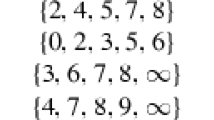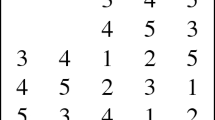Abstract
Almost designs (t-adesigns) were proposed and discussed by Ding as a certain generalization of combinatorial designs related to almost difference sets. Unlike t-designs, it is not clear whether t-adesigns need also be \((t-1)\)-designs or \((t-1)\)-adesigns. In this paper we discuss a particular class of 3-adesigns, i.e., 3-adesigns coming from certain strongly regular graphs and tournaments, and find that these are also 2-designs. We construct several classes of these, and discuss some of the restrictions on the parameters of such a class. We also construct several new classes of 2-adesigns, and discuss some of their properties as well.
Similar content being viewed by others
References
Assmus E.F., Key J.D.: Designs and Their Codes, vol. 103. Cambridge University Press, Cambridge (1992).
Behbahani M.: On strongly regular graphs. PhD thesis, Concordia University (2009).
Beth T., Jungnickel D., Lenz H.: Design Theory, vol. I, 2nd edn. Cambridge University Press, Cambridge (1999).
Bose R.C.: On the construction of balanced incomplete block designs. Ann. Eugen. 9, 353–399 (1939).
Cameron P.J., van Lint J.H.: Designs, Graphs, Codes and Their Links. London Mathematical Society Student Texts. LMSSTCambridge University Press, Cambridge (1991).
Cusick T.W., Ding C., Renvall A.: Stream Ciphers and Number Theory, vol. 55. North-Holland Mathematical LibraryNorth-Holland Publishing Co., Amsterdam (1998).
Davis J.A.: Almost difference sets and reversible divisible difference sets. Arch. Math. (Basel) 59(6), 595–602 (1992).
Dembowski P.: Finite Geometries. Springer, New York (1968).
Ding C.: The differential cryptanalysis and design of natural stream ciphers. In: Fast Software Encryption, pp. 101–115. Springer, Berlin (1994).
Ding C.: Codes from Difference Sets. World Scientific Publishing Co. Pte. Ltd., Hackensack, NJ (2015).
Ding C., Yin J.: Constructions of almost difference families. Discret. Math. 308(21), 4941–4954 (2008).
Ding C., Helleseth T., Martinsen H.: New families of binary sequences with optimal three-level autocorrelation. IEEE Trans. Inform. Theory 47(1), 428–433 (2001).
Ding C., Pott A., Wang Q.: Skew Hadamard difference sets from Dickson polynomials of order 7. J. Comb. Designs 23(10), 436–461 (2015).
Fisher R.A.: An examination of the different possible solutions of a problem in incomplete blocks. Ann. Eugen. 10, 52–75 (1940).
Goethals J., Seidel J.: Orthogonal matrices with zero diagonal. Can. J. Math. 19, 1001–1010 (1967).
Golomb S.W., Gong G.: Signal Design for Good Correlation: For Wireless Communication, Cryptography, and Radar. Cambridge University Press, Cambridge (2005).
Hirschfeld J.W.P.: Projective Geometries Over Finite Feilds, 2nd edn. Oxford University Press, Oxford (1998).
Horsley D.: Generalizing Fisher’s inequality to coverings and packings. Combinatorica 37(4), 673–696 (2017).
Huffman W.C., Pless V.: Fundamentals of Error-Correcting Codes. Cambridge University Press, Cambridge (2003).
Johnson S.: A new upper bound for error-correcting codes. IRE Trans. Inform. Theory 8, 203–207 (1962).
Liu H., Ding C.: Infinite families of 2-designs from ${GA}_{1}(q)$ actions. arXiv:1707.02003v1 (2017).
Michel J.: New partial geometric difference sets and partial geometric difference families. Acta Math. Sin. 33(5), 591–606 (2017).
Michel J., Ding B.: A generalization of combinatorial designs and related codes. Des. Codes Cryptogr. 82(3), 511–529 (2016).
Neumaier A.: $t\frac{1}{2}$-designs. J. Comb. Theory (A) 78, 226–248 (1980).
Pasechnik D.: Skew-symmetric association schemes with two classes and strongly regular graphs of type $l_{2n-1}(4n-1)$. Acta Appl. Math. 29(1), 129–138 (1992).
Reid K., Brown E.: Doubly regular tournaments are equivalent to skew hadamard matrices. J. Comb. Theory (A) 12(3), 332–338 (1972).
Schonheim J.: On coverings. Pac. J. Math. 14, 1405–1411 (1964).
Stinson D.R.: Combinatorial Designs: Constructions and Analysis. Springer, New York (2003).
Storer T.: Cyclotomy and Difference Sets, pp. 65–72. Markham, Chicago (1967).
Wang X., Wu D.: The existence of almost difference families. J. Stat. Plan. Inference 139(12), 4200–4205 (2009).
Wilson R.M.: Cyclotomy and difference families in elementary abelian groups. J. Number Theory 4, 17–47 (1972).
Zhang Y., Lei J.G., Zhang S.P.: A new family of almost difference sets and some necessary conditions. IEEE Trans. Inform. Theory 52(5), 2052–2061 (2006).
Acknowledgements
The authors are very grateful to the three anonymous referees and to the Coordinating Editor for all of their detailed comments that greatly improved the quality and the presentation of this paper.
Author information
Authors and Affiliations
Corresponding author
Additional information
Communicated by C. Ding.
Publisher's Note
Springer Nature remains neutral with regard to jurisdictional claims in published maps and institutional affiliations.
The authors were supported by the National Science Foundation of China under Grant No. 11601220.
Appendix
Appendix
We will need some facts about cyclotomic classes and cyclotomic numbers. Let \(q=ef+1\) be a prime power, and \(\gamma \) a primitive element of the finite field \(\mathbb {F}_{q}\) with q elements. The cyclotomic classes of order e are given by \(D_{i}^{(e,q)}=\gamma ^{i}\langle \gamma ^{e} \rangle \) for \(i=0,1,\ldots ,e-1\). The cyclotomic numbers of order e are given by \((i,j)_{e}=|D_{i}^{(e,q)}\cap (D_{j}^{(e,q)}+1)|\). It is obvious that there are at most \(e^{2}\) different cyclotomic numbers of order e. When it is clear from the context, we will simply denote \((i,j)_{e}\) by (i, j).
We will need to use the cyclotomic numbers of order 2.
Lemma 7
[29] For a prime power q, if \(q \equiv 1\) (mod 4), then the cyclotomic numbers of order two are given by
If \(q \equiv 3\) (mod 4) then the cyclotomic numbers of order two are given by
Lemma 8
Let q be an odd prime power. Let \(G=(\mathbb {F}_{q},+)\times (\mathbb {F}_{q},+)\), and define
and
Then both D and \(\tilde{D}\) are \((q^{2},\frac{q^{2}-2q+1}{2},\frac{q^{2}-4q+7}{2},\frac{q^{2}-4q+3}{2})\) partial difference sets.
Proof
The case for D was shown in [32]. To show that for \(\tilde{D}\), we count the number of solutions to the equation
where \((a_{1},b_{1}),(a_{2},b_{2})\in \tilde{D}\). We use a method similar to that used in [32].
Assume that a and b are both square. If \(a_{1}\) and \(a_{2}\) are square and \(b_{1}\) and \(b_{2}\) are nonsquare, then, using Lemma 7, the number of solutions to (10) is \((0,0)_{2}(1,1)_{2}\). There are three other cases depending on which of \(a_{1},a_{2},b_{1}\) and \(b_{2}\) are square and which are nonsquare, and the number of solutions to (10), as we run over these other possibilities, is one of \((0,1)_{2}(1,0)_{2},(1,0)_{2}(0,1)_{2}\) or \((1,1)_{2}(0,0)_{2}\). Summing over all four possibilities, the total number of solutions to (10) when a and b are both square is \(\frac{q^{2}-4q+3}{4}\) (regardless of the residue of q modulo 4).
The other three cases where neither a nor b are zero can be argued similarly. When a and b are both nonsquare, the total number of solutions to (10) is \(\frac{q^{2}-4q+3}{4}\), and when one of a and b is square and the other is nonsquare, the total number of solutions is \(\frac{q^{2}-4q+7}{4}\). If \(a\ne 0\) and \(b=0\) then (10) becomes \((a_{2}a^{-1},b_{2})+(1,0)=(a_{1}a^{-1},b_{1})\) which, using Lemma 7 again, has \(((0,0)_{2}+(1,1)_{2})\frac{q-1}{2}=\frac{q^{2}-4q+3}{4}\) solutions. A similar argument shows that when \(a=0\) and \(b\ne 0\) the number of solutions to (10) is again \(\frac{q^{2}-4q+3}{4}\). Thus, if \(x,y\in G\) are distinct, we have that each member of \(\tilde{D}\) appears as a difference of two distinct members of \(\tilde{D}\), \(\frac{q^{2}-4q+7}{4}\) times, and each member of \(G\setminus (\tilde{D}\cup \{(0,0)\})\) appears as a difference of two distinct members of \(\tilde{D}\), \(\frac{q^{2}-4q+3}{4}\) times. This completes the proof. \(\square \)
Rights and permissions
About this article
Cite this article
Michel, J., Wang, Q. Almost designs and their links with balanced incomplete block designs. Des. Codes Cryptogr. 87, 1945–1960 (2019). https://doi.org/10.1007/s10623-018-00596-4
Received:
Revised:
Accepted:
Published:
Issue Date:
DOI: https://doi.org/10.1007/s10623-018-00596-4




